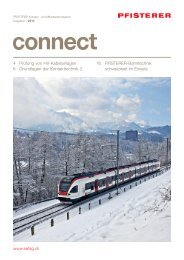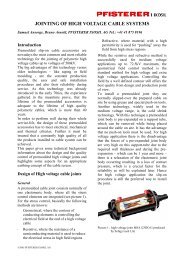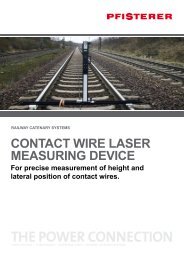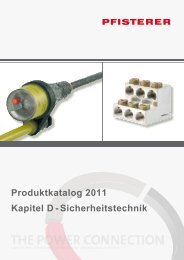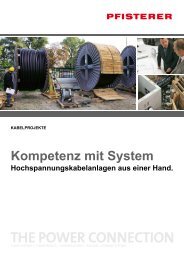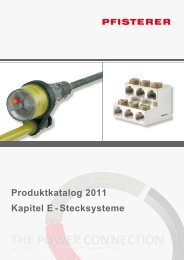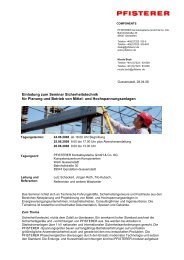Bending of helically twisted cables under variable ... - Pfisterer
Bending of helically twisted cables under variable ... - Pfisterer
Bending of helically twisted cables under variable ... - Pfisterer
You also want an ePaper? Increase the reach of your titles
YUMPU automatically turns print PDFs into web optimized ePapers that Google loves.
As As is well well known known from earlier observations observations [EPRI, 1979], and and also also intuitive, intuitive, the wires in a cable beg begin to<br />
move on their <strong>under</strong>lying layer when a certain curvature is exceeded - Fig. 2.8.:<br />
Fig. 2.8 Wire displacement during bending<br />
The position on the cable cross-section section where the displacement starts starts and the affected length <strong>of</strong> <strong>of</strong> the<br />
specific wire depend on whether the secondary stress in the non-displaced displaced wire, as calculated in (2.22),<br />
exceeds the maximum value that can be resisted by friction (2.17).<br />
By equating the abovementioned equations (2.17) and (2.22) for ϕ → π/2 /2 and solving for the curvature,<br />
we find:<br />
Thus σzus,L (2.22) > σzus,L (2.17), which is valid also for all wires <strong>of</strong> the considered cross<br />
therefore therefore assumed that that the the specific specific individual individual wire wire will slide over its entire length length once this this “final”<br />
“final”<br />
curvature is exceeded.<br />
The displacement starts at position ϕϕ,<br />
, however, where the slope <strong>of</strong> (2.22) exceeds the slope <strong>of</strong> (2.17) for<br />
the the first time, Fig. 2.9. As As shown shown earlier earlier [Leider, [Leider, 1973], this this is the case almost almost exactly where ϕ = 0, (also<br />
see Fig. 2.7). The curvature associated with the start <strong>of</strong> slipping is:<br />
With With partial partial slippage slippage therefore, the secondary stress stress in in a a wire wire is is governed in sections by the two curves<br />
<strong>of</strong> <strong>of</strong> equation equation (2.17) (2.17) and and (2.22), (2.22), Fig. 2.9. 2.9. The bending bending region region where both stress conditions “coexist” along<br />
the wire is called the transition region. This region will be dealt with later.<br />
17<br />
(2.17), which is valid also for all wires <strong>of</strong> the considered cross-section. It is



